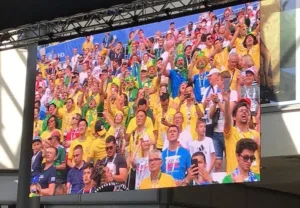While you were reading my last article pondering my chance of buying a micro-LED TV, I had the pleasure to visit Germany and attend some family festivities. In a coincidence, the world soccer championship in Russia started around the same time I arrived in Germany.

With some travel I spent time in different places all focusing on bringing the soccer games to the masses and employing various technologies to provide the best quality images possible. Even after the early exit of the German soccer team after the group stage (well deserved, I have to add), the viewing options were plentiful.
This kind of sport event triggered something that Europeans are calling public viewing and can be best described as a party with moving pictures, at least for the fans of the winning team. The viewing places are set up by the various venues, may they be a town, a shopping center or just a Biergarten (for the readers not familiar with this concept I urgently recommend a trip to Germany in summer). Back to the venues, it is up to the organizer to choose the display technology best suited for the intended use. There was a lot of hit and miss with this and I am documenting some of the results in this article.
As a side note, most games were played and broadcast during the day as the games took place in Russia. The last games started at 8pm middle European time, a time where the sun is still up in the sky and slowly setting throughout the game time. This did make for some challenging ambient lighting conditions for outdoor viewing.
LCD TV
The easiest and cheapest solution was to put a large LCD TV outside and turn it on. The resulting images were of course mixed, as you expect. None of the TVs I saw were actual outdoor enabled devices, just an indoor TV with the brightness turned up all the way. Where the viewing space was indoors, the resulting image quality was the same as in every sports bar around the globe. The colors are as good as the TV was able to produce them and the existing large size TVs allowed decent viewing in the 5m to 15m distance range (15 feet to 45 feet).
However, when the TV was placed in an outdoor space the results were mediocre at best. With good control of the ambient lighting the result was often acceptable but in other cases the results were not so good. If the TV faced any kind of direct sunlight or even some reflected rays the picture mostly disappeared, leaving the viewer to guess what was going on.
I would guess that the typical size range of the used TVs was in the 55” to 70” range, creating the smallest viewing venue of all the used display technologies.
I don’t believe that anyone needs a picture to have an idea how a LCD TV looks in this application. All in all, LCD works well in a smaller venue as long as there is very good ambient light control. Some ambient light is okay as long as direct sunlight is being blocked and the TV has a high brightness setting to begin with.
Front-projectors
The other widespread technology deployed was a projector with a screen. The used projectors were all home entertainment projectors with real high end projectors missing from all the venues I visited. One explanation is of course that the smaller venues I visited did not have the money to hire a rental and staging company providing a higher end experience. The used projectors were all larger sized units with the highest lumen output available. Screens were typical neutral flat white surfaces with no gain.
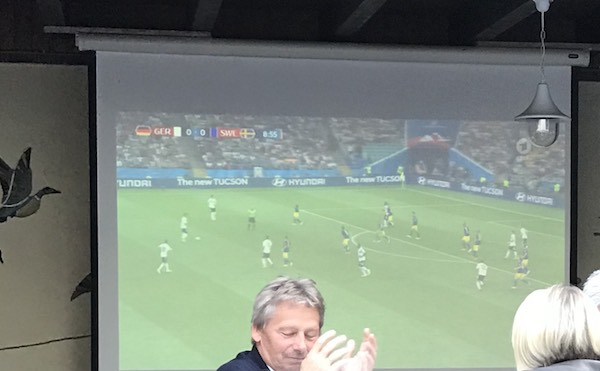 Front Projector Viewing in a Restaurant
Front Projector Viewing in a Restaurant
Most screens were larger than the 70” limit the LCD TVs had. As a consequence, this technology was used in larger venues where people were further away from the screens. As a result, most of the time images were washed out and if any kind of sunlight was hitting the screen, there just wasn’t any image left. All the installations I saw were front projectors. There were no short throw or rear projection systems used for this kind of viewing.
The set up cost is reasonable and after the event is over, the owner of the venue goes home with a nice home projector. In most cases the set up was screaming “DIY”, including some very innovative ways to block out the ambient light as shown in the images below.
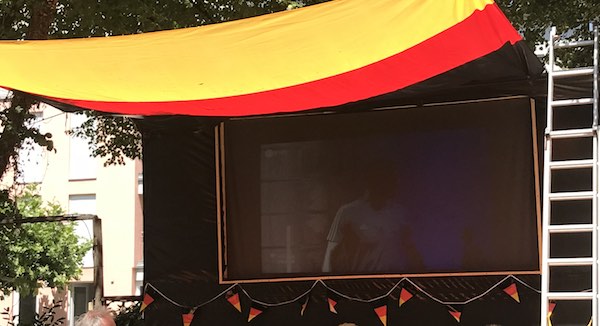 Front Projector Viewing in a Biergarten
Front Projector Viewing in a Biergarten
Of all the methods used, this was my by far least favorite display technology. In many cases there was no image to watch on part of the screen.
While I did not see a rear projector viewing of the world cup, I did come across a rear projector in a storefront and took some pictures. The images were soft and washed out, however looking at the image I took with the camera (on my iPhone I may add) I saw an interesting effect. The actual image did not show up, only some color bands. Does anyone have an explanation for that?
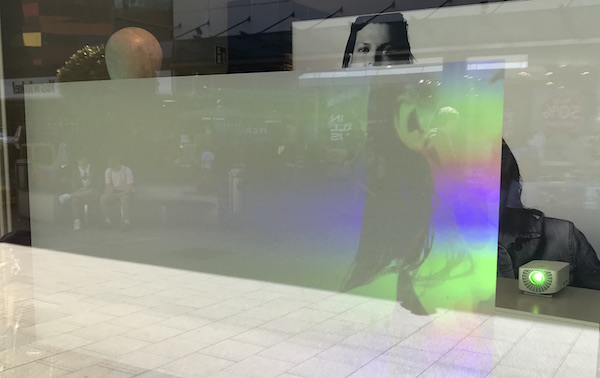 The Rear Projector in the Storefront did not provide a captureable image
The Rear Projector in the Storefront did not provide a captureable image
LED
Besides the argument of what Mini-LED is, let me say that I am using this term here for a typical digital signage set-up as can be seen on malls and outdoor advertising around the world. This particular set up was a good size and well calibrated. In moving images there was no brightness variance visible and even the edges of the display tiles disappeared completely. When there was a uniform color displayed on the screen some lines became visible.
LED Wall from the Front
This was the largest display by far with a screen width of around 5m (15 feet) allowing good viewing from distances up to 20m (60 feet). There was a stadium like seating installed in the middle of the shopping center with a minimum viewing distance of around 10m (30 feet). This was plenty to avoid any visible pixelation on the screen. Moving closer made those pixels stand out strongly, but there was no need to be any closer than the first row seats.
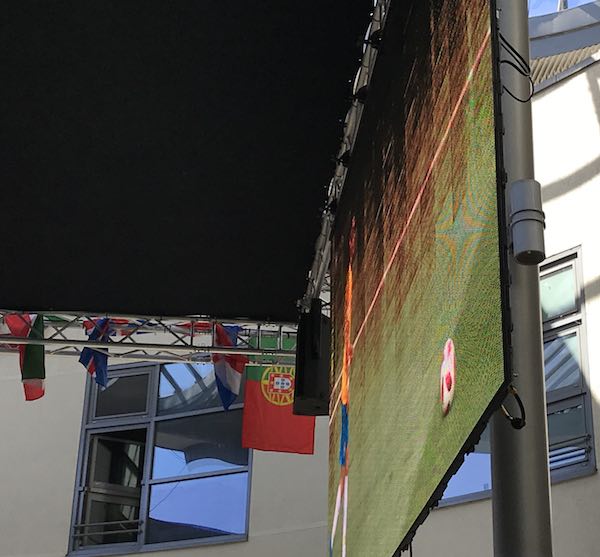 LED Wall under Extreme Viewing Angle
LED Wall under Extreme Viewing Angle
Only under extreme viewing angles were technology artifacts like tile lines visible. The viewing angle where this occurred was at least 80º and pretty unusable for viewing the game anyway. There was a roof over the display, so direct sunlight was eliminated, but the screen was plenty bright and no ambient light artifacts were visible on the screen.
All in all this was my favorite display technology for this kind of environment.
Considering the price of this technology, only large venues will be able to afford this, however if one could come up with a reasonable priced version, I believe this may be a good rental opportunity for these type of events. The drive to lower prices has been going on for years and I doubt that there is enough room for the prices to ever reach consumer levels. The remaining question is what do with the equipment for the rest of the year. At the right price point some venues, like the shopping center I visited, maybe easily swayed to invest into a fixed installation that can be used for public viewings to attract customers all year around.
Considering the next world cup and viewing it in my backyard I would opt for the LED Wall and since it is four years away I can save some serious cash starting today. – NH

